The signs for the possible winner of the three points at Vicarage Road on Tuesday evening could not have been much clearer. Manchester City were the favourites before the kick-off to continue their unbeaten run in this Premier League season and they did so. Though, The Hornets managed to score in the 85th minute and retain the possibility of winning a point on their home ground until the very last minute.
Line ups
Watford (4-3-2-1): Foster – Holebas, Cathcart, Kabasele, Femenía – Doucouré, Chalobah, Hughes – Pereyra, Success – Deeney
Manchester City (4-3-3): Ederson – Delph, Kompany, Stones, Walker – D.Silva, Fernandinho, B.Silva – Sané, Jesus, Mahrez
City’s build up structure
At the beginning of the match, City tried to build up with a back-three consisting of Kompany, Stones and Walker while Delph pushed into midfield (P1). The reason for a back-three in build up phases was probably Guardiola’s expectation of Watford defending in a 4-4-2, like they did in their previous matches. A back-three would provide a majority with the lowest number of players needed (3 vs 2).

Contrary to his assumption, Watford used three players up front which made City switch to a back-four very early (P2). The organisation of City’s midfield and forward line was clear.
Fernandinho supported Kompany and Stones to build up from the back, Bernardo and David Silva usually pushed high up the halfspaces to create space for Fernandinho and Delph at the beginning. In order to stretch the opponent’s back-four as much as possible, Sané and Mahrez stayed very wide.

Watford’s defensive approach
In the first half of the match, Watford mostly pressed very deep which was not a surprise. Javi Gracia’s team aimed to close the middle in front of their box. This made City attack down the wings often. Of course, Gracia was aware of the 1 vs 1 strength of City’s wingers and therefore especially Pereyra had to track back very often. This allowed him to join the fullback and build a 2 vs 1 situation or give Holebas the opportunity to stay behind him and “cover” if Pereyra loses the duel (P3). The central midfielders also had the task to support these duels on the wings.

Furthermore, keeping the space tight between back-four and the midfield was vital in order to defend City’s attacks. Bernardo and especially David Silva are well-known for their strengths in exploiting that space. The low distance between the lines prevented them from receiving the ball there and having the possibility to turn around and face a centre-back (P4).

Even though a vertical compactness to such an extent deep in the own half can be advantageous in terms of avoiding chances, it comes along with disadvantages in terms of creating quick counter attacks because the positioning of the players doesn’t allow a quick progress of the ball to the opponent’s goal. Even if Watford tried to progress up the pitch quickly, City managed to regain possession very quickly due to their good positional structure before losing the ball and the attitude of their players to press the opponent at a high-intensity level (P5). The result was only one serious chance for Watford in the first half.

Most of the time Watford defended well. City used to switch play constantly and tried to find space between the lines which didn’t work due to Watford’s discipline.
Though, in consequence of the deep positioning and passivity of The Hornets’ midfield-three, there was space in front of them which Mahrez and B.Silva exploited to bring in diagonal crosses to the far post from the halfspaces. Even though these crosses weren’t promising most of the time, they brought the lead for The Citizens after Mahrez’s cross found Sané at the far post in the 40th minute.
For the rest of the time in the first half, they were only able to create serious chances through a bad pass from Pereyra in the 11th minute and bad collective positioning of the midfield and defence in the 19th minute.
Different style in the second half
Early in the second half, City managed to score for a 2-0 lead. They overloaded the left wing and managed to combine themselves through Watford’s defence. Gabriel Jesus put in a low cross and Mahrez converted. At this moment Watford’s entire defence were focussed on the ball which left a lot of space free for Mahrez to finish.
This meant that Watford would have to change something if they wanted to come back. Consequently, they started to press higher up the pitch. The issue from that moment on was the inconsistent quality of their pressing structure. Even though City are very comfortable at playing out from the back, Watford were leaving too many gaps. These gaps and the occasional asymmetry in The Hornets’ pressing helped City to escape the pressure (P6, P7).


In the second half, Bernardo Silva and especially Fernandinho were the key-players to play through Watford’s pressing. Their clever movements behind the first pressing-wave were very important for City in order to progress up the pitch. They have also benefitted by the missing horizontal and vertical compactness of Gracia’s side (P8). These were the reasons which were making it very easy for Guardiola’s team to even play comfortably through the middle which wasn’t the case in the first half.

It is also worth mentioning City’s exceptional qualities with the ball. At many occasions, they attracted pressure from Watford’s players with overloads and short passes in order to move apart the opponent’s lines from each other (P9). Furthermore, they applied the “concept of the third man” a couple of times (P10).
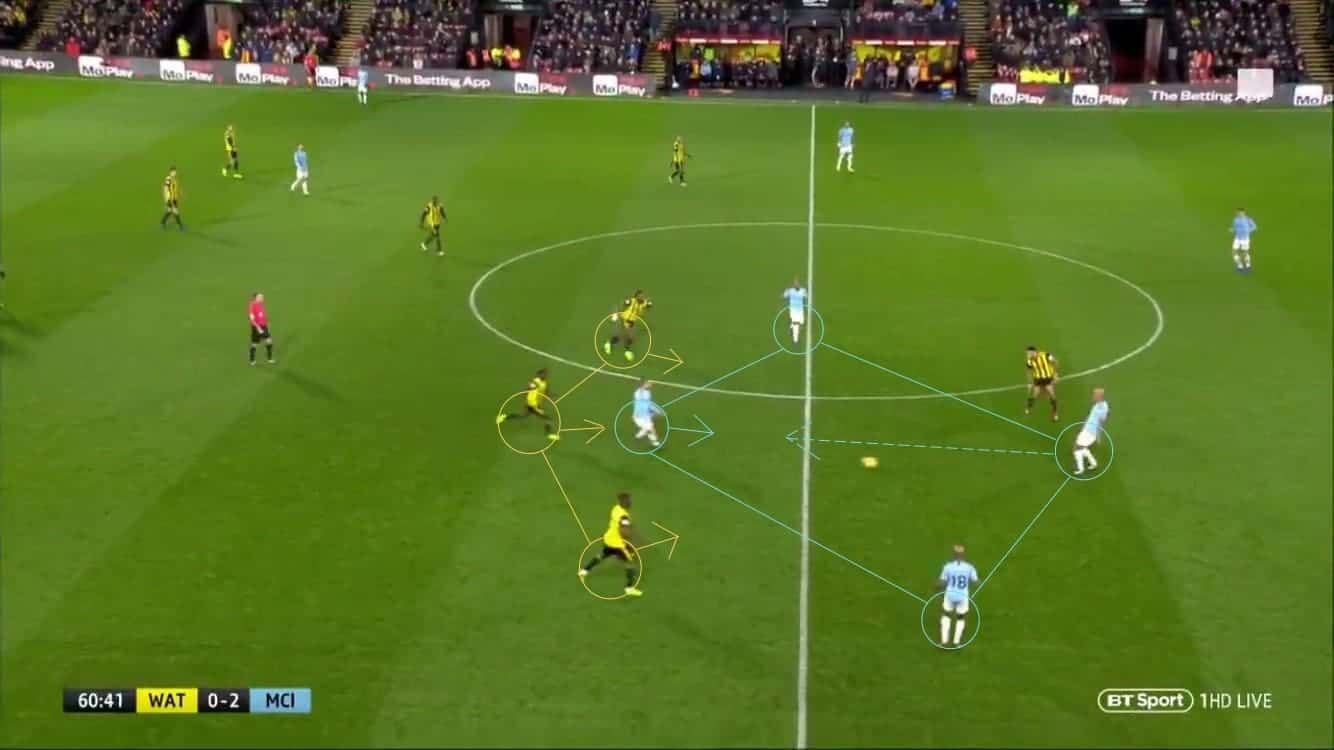
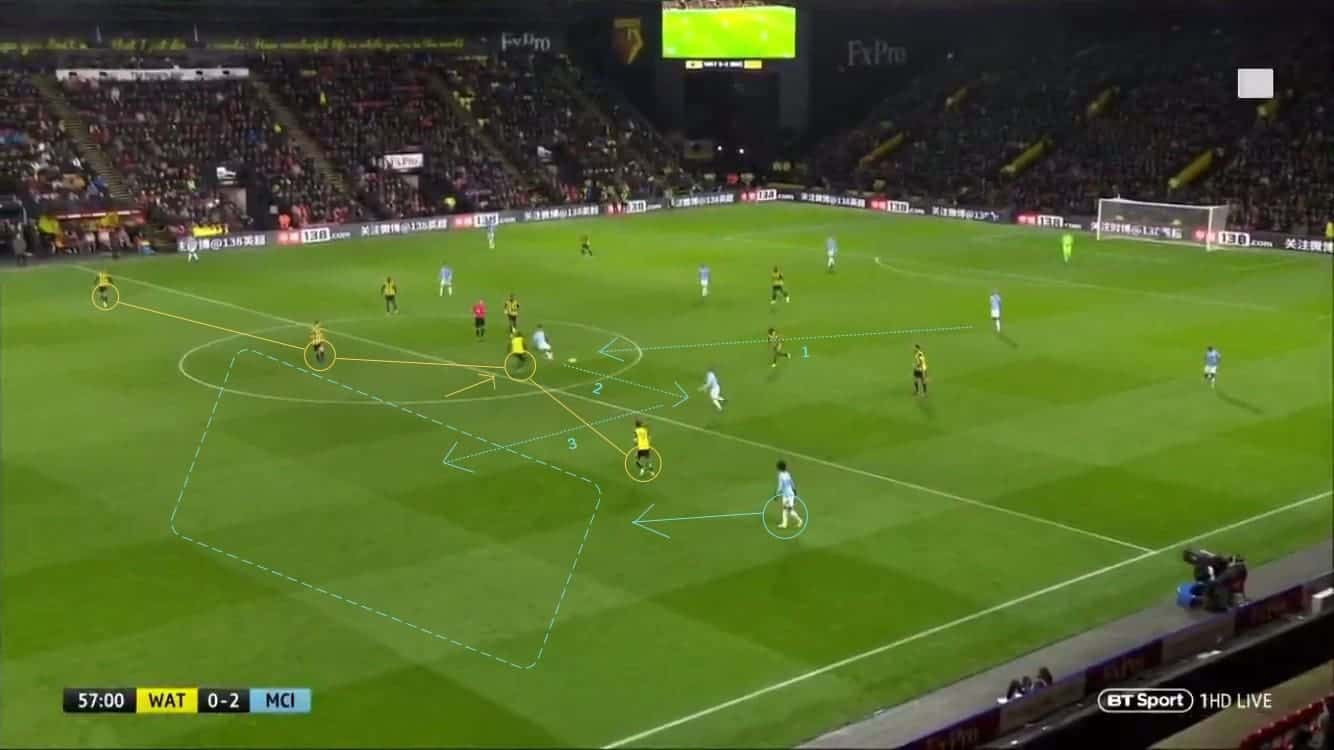
In P10, you can see that City’s passing and positional play disorganises Watford’s structure completely. Jesus comes deep to receive the pass from Kompany and then passes to the “third man” (David Silva). Sané and Mahrez are positioned very wide which stretches Watford’s back-four. Jesus’ dropping draws Kabasele out of his position and creates a huge gap. Sané recognizes the gap and runs into it and Silva passes the ball.
Even though Guardiola’s side’s passing was brilliant at times, they failed to score a third goal and secure the three points early. This allowed Watford to come back.
Watford coming back
Manchester City didn’t manage to score a third goal, but still they were defending very well. Their effort in pressing and counter-pressing was remarkable (P11).
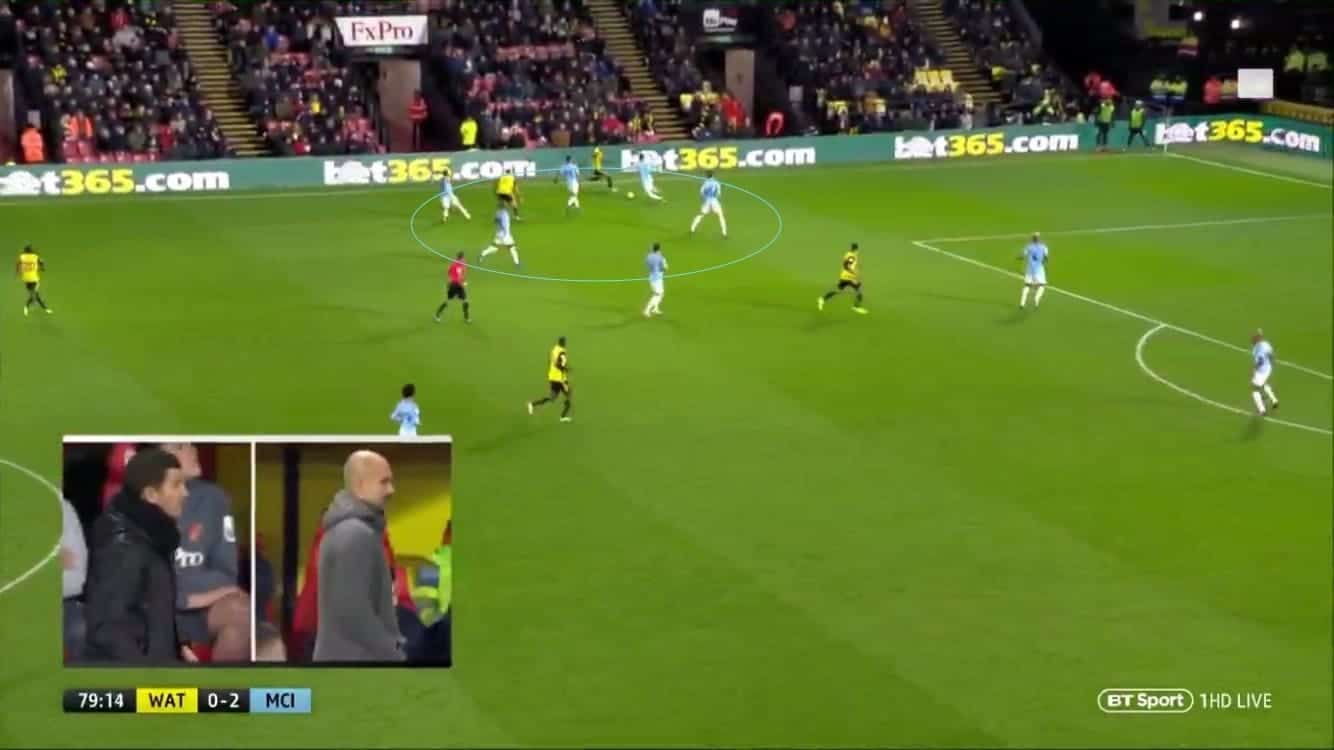
In the second half, Watford had more possession in City’s half than in the first half of the match, but they struggled to create chances. This was mostly due to City’s good defending, but Watford also didn’t occupy the space as well as The Citizens did (P12).
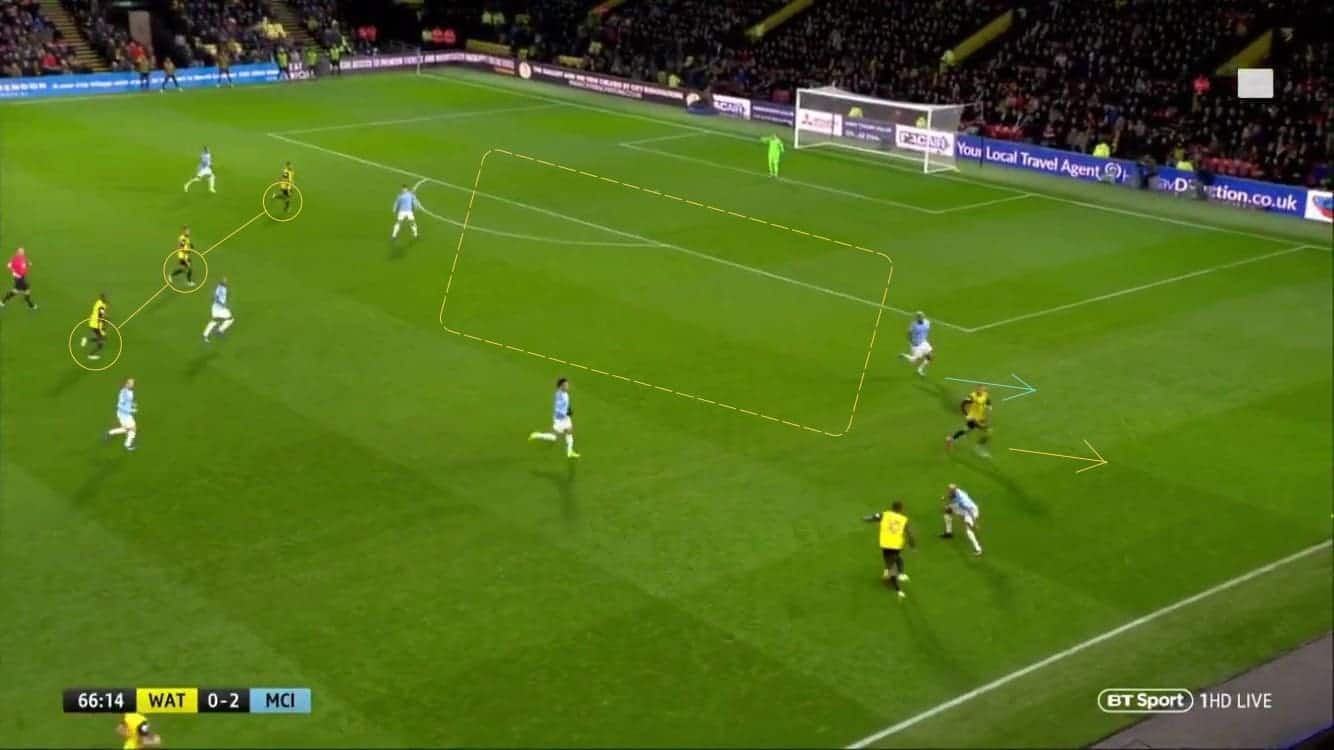
Watford’s goal after 84 minutes was a result of Delph’s bad decision. Deulofeu pressed him while closing the passing lane to Sané with his cover shadow, but Delph still tried to pass the ball to Sané instead of Fernandinho or Gündoğan. Deulofeu’s cross found Doucouré who reduced City’s lead.
Conclusion
Until City’s 2-0 lead Watford used to defend disciplined. Then, they began pressing high up the pitch, but their pressing wasn’t well structured most of the time. Because of City’s brilliance in this season, it seemed almost exceptional that City failed to take advantage of it and let them come back into the match which kept the outcome of the match opened until the final whistle.
If you love tactical analysis, then you’ll love the digital magazines from totalfootballanalysis.com – a guaranteed 100+ pages of pure tactical analysis covering topics from the Premier League, Serie A, La Liga, Bundesliga and many, many more. Get your copy of November’s issue for just £4.99 here or preorder the first of TWO December issues right here.

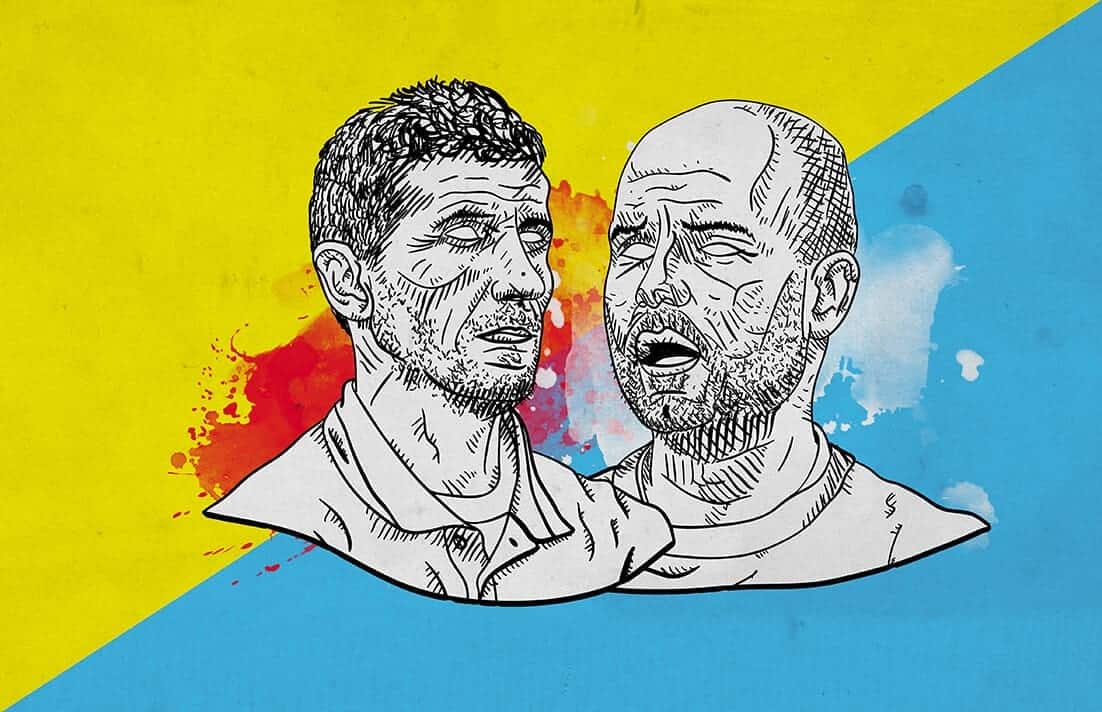



Comments